Clash of the Teutons: BMW M3 Sport Evolution vs. Audi Coupe S2 vs. Mercedes 190E 2.5-16 Evo II
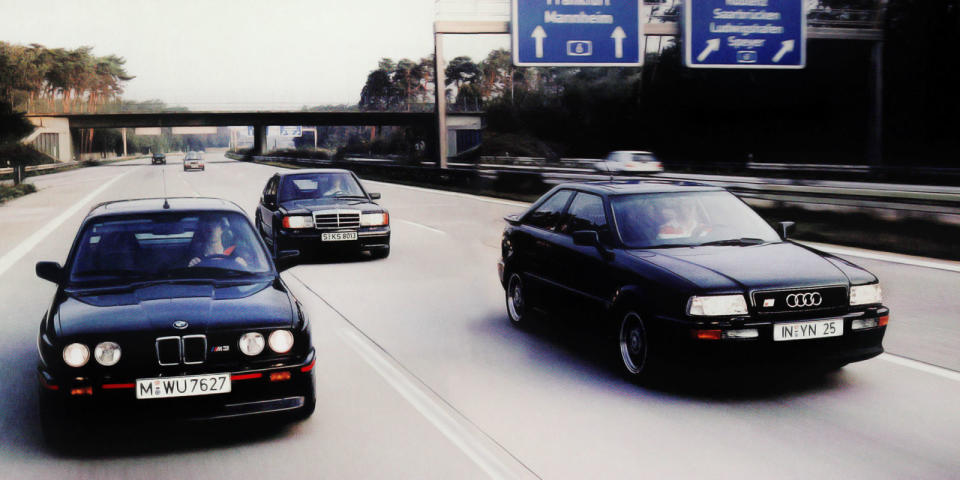
From the October 1991 issue of Road & Track
The German town of Hockenheim is perfect for comparison tests. In addition to having one of R&T European Editor Paul Frere's favorite Greek restaurants-essential for discussing the cars after a good day of driving-it also affords access to the freedom of Autobahnen, the beauty of country roads and the majesty of Hockenheimring, a world-class race circuit nestled in the woods.
From Ingolstadt, Munich and Stuttgart we gathered an Audi Coupe S2, a BMW M3 Sport Evolution and a Mercedes-Benz 190E 2.5-16 Evolution II and lined them up, toe to toe and tire to tire, in and around Hockenheim. There could be no more fitting a place for these three makes to square off than Hockenheim. After all, full-on race versions of the BMW M3. Mercedes 190E 2.5-16 and Audi V8 have been chasing each other around Hockenheimring, Nurburgring and other tracks and street circuits all year in pursuit of the victor's trophy in the Group A German Touring Car Championship.
Each of the three cars in our test is a sort of hybrid machine, its spirit placed somewhere between that of a road car and that of a race car.
Each is significant as it represents the forefront of its maker's technological abilities, from computerized engine-management systems to aerodynamics. Each is also a limited-production car that may or may not ever see American roads deserving of its talent. And so it was that we traveled to Germany and assembled three of the best and brightest " something-extra" cars that the country has to offer. We poked, prodded, tested and pushed them on a race track, experienced them flat-out on the last public frontier of high-speed driving-the German Autobahn-and enjoyed them on the lovely secondary and tertiary roads in the southern province ofBaden-Wiirttemberg.
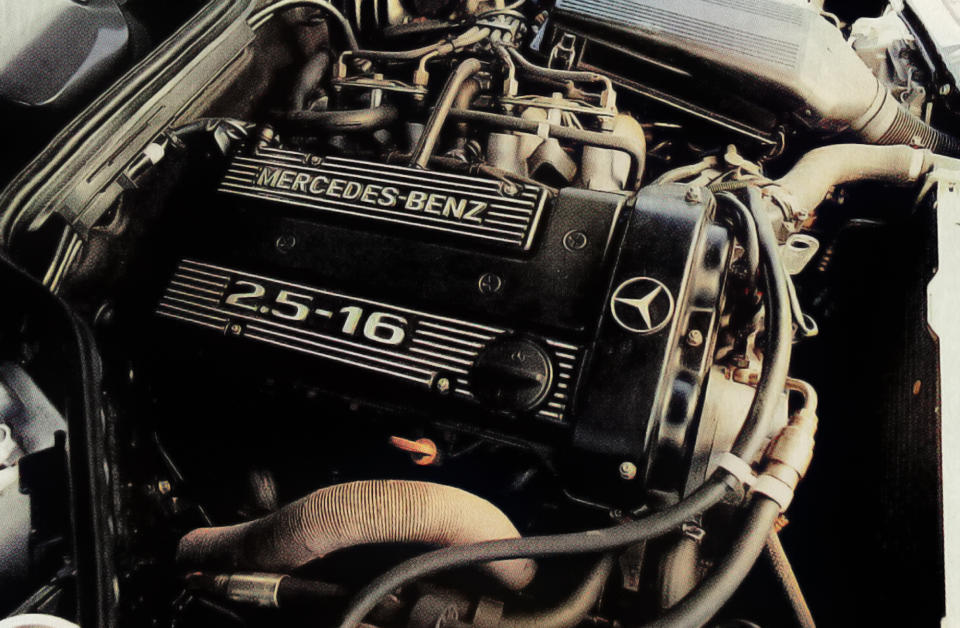
The spiritual essences of the three cars are, of course, their engines. Motivation for our Teutonic trio is supplied by two normally aspirated DOHC 16-valve 2.5-liter 4-cylinder powerplants (in the M-B and BMW) and one turbocharged DOHC 20-valve 2.2-liter inline-5 (naturally belonging to the Audi).
The journey that a stock 190E 2.5-16 engine takes on its way to becoming an Evolution II engine is a short but meticulous one. Slight modifications in compression ratio, valve lift and timing, intake porting, combustion chambers, catalytic converters and computer chips combine to con tribute more muscle to the Mercedes. At the end of the day, the Evolution II puts out 232 bhp DIN and 181 lb.-ft. of torque compared with the stock 2.5-16's 195 bhp and 170 lb.-ft. of torque, and the tachometer allows 500 rpm more reach before redlining at 7700.
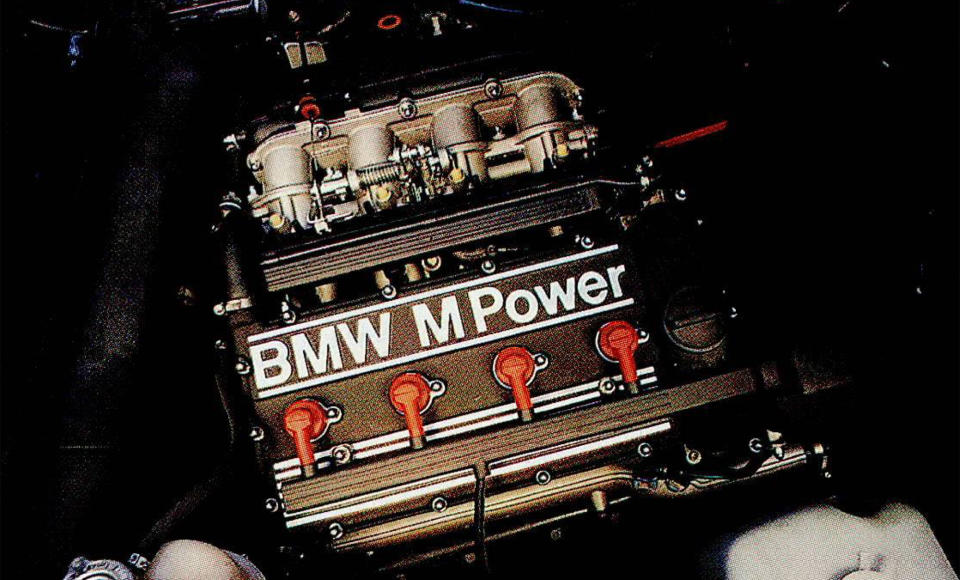
As if to match its Group A rival in Stuttgart, BMW bored and stroked the stock M3's 2.3-liter four into a 2.5, bringing its volume to within a few capfuls of the Mercedes engine. Thus stretched, the new BMW M3 Evolution engine produces 238 bhp DIN and 177 lb.-ft. of torque.
Comparisons of the 2.5-liter powerplants came naturally to the drivers: "The Mercedes' engine seems slightly less aggressive than the BMW's (keeping in mind that the M-B is more than 300 lb. heavier)," began one entry in the Evo II's notebook, " but it is exceptionally smooth for a big four right up to its 7700-rpm limit."
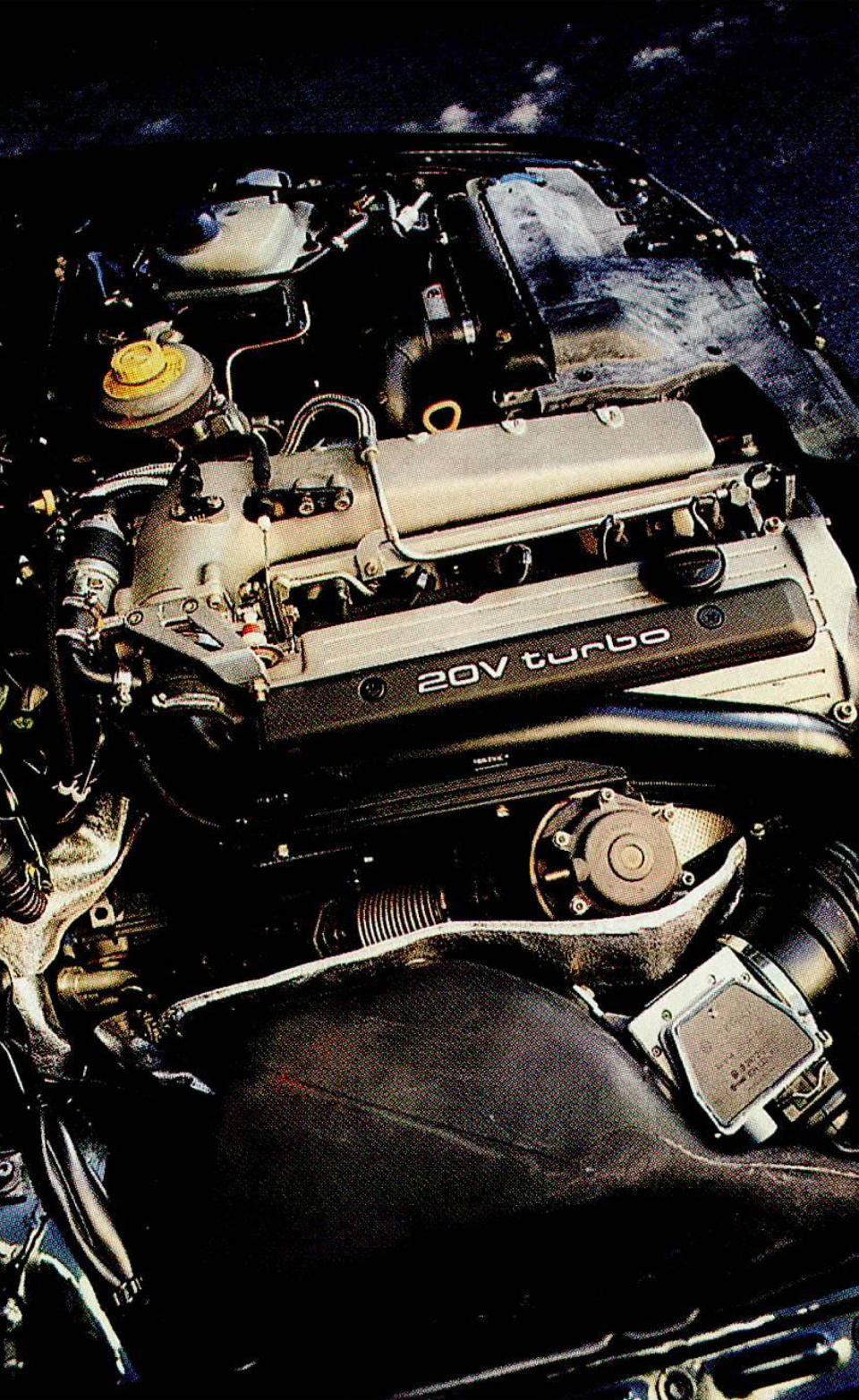
Another driver contrasted the two engines this way: "The BMW's engine, which is not quite as smooth as the Mercedes', has fair midrange torque and revs beautifully, if loudly, to the upper limits."
Moving up in piston count, but deceptively down in horsepower is the Audi Coupe S2. Ingolstadt is justifiably proud of the S2's deep-breathing, intercooled 220-bhp DIN straight-5, which descended from the Sport Quattro's 306-bhp competition engine. Although it came up about 250 cc and a few bhp shy of its 2.5-liter competitors, the S2 engine was far from being the runt of our test litter. You see, if the Audi couldn't win the horsepower numbers war, its race-bred 2.2-liter turbocharged engine–with ignition program re-mapped and turbo boost boosted-still approaches that magic 100-bhp-per-liter benchmark. And the S2 engine's torque characteristics-a significant 228-lb.-ft. cranked at an appreciably low 1950 rpm-slammed the door on the two Evolution cars.
"I suspect that the Audi's performance is quite deceptive," wrote one perceptive editor. " It has the smoothest and torquiest engine, with very good turbo response."
The Coupe S2 complied with that editor's impressions by posting a 6.0-second 0-to-60-mph time-fully a half-second quicker than the BMW and 0.9 sec. more fleet than the Mercedes. The Audi proved itself adept not only as a sprinter, but as a quarter-miler as well, once again besting the competition with a 14.6-sec. run.
The power created by each of the 4-wheeled lions in our test was transmitted through a 5-speed manual transmission. The Audi's shift pattern is the familiar one, but the Mercedes and BMW gearboxes come with a racing shift configuration. First gear is down and to the left and the other four forward gears make up the "H" pattern. The gate for reverse is at the upper left, above 1st.
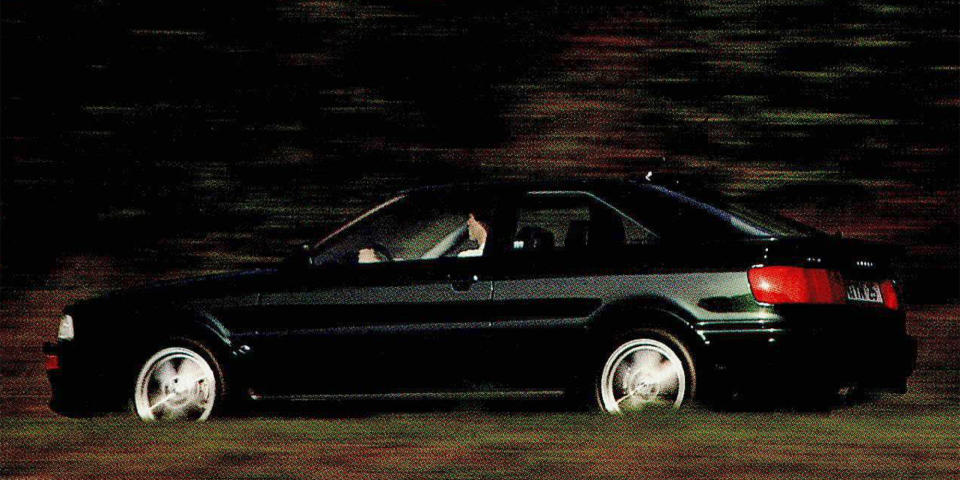
And it was in this transmission realm that we discovered one of the few areas where all three cars shuffled their feet.
" The Mercedes' gearbox is too notchy," complained one notebook entry. "The M3's gearbox is quick, but slightly notchy," said another. Even the S2 couldn't escape some criticism: " In hard driving, the shifter's notchiness is magnified. The gearbox has a rubbery feel to it, with imprecise gates."
Despite our dissatisfaction with the feel and action of the three gearboxes, we agreed that the ratios were well matched with their respective engines.
Because of the exacting nature of much of the driving we were doing, we paid a lot of attention to how well the cars reacted to steering inputs and how well the feedback through the steering wheel was connecting us to the roads. Power-assisted steering systems-rack-and-pinion on the S2 and the M3, recirculating-ball on the Mercedes Evo II-appealed to us in varying degrees, but as a general rule, the surest way of receiving our praise was by not getting in the way of our driving. This is where the Audi Coupe S2 received some of its most stern criticism: "The Audi's boosted steering is much too light. The boost is speed-sensitive, but the effort remains too light throughout the spectrum. This gives a disconnected feeling to the driver, one step further away from the road than I am comfortable with, especially at higher speeds on sweeping corners."
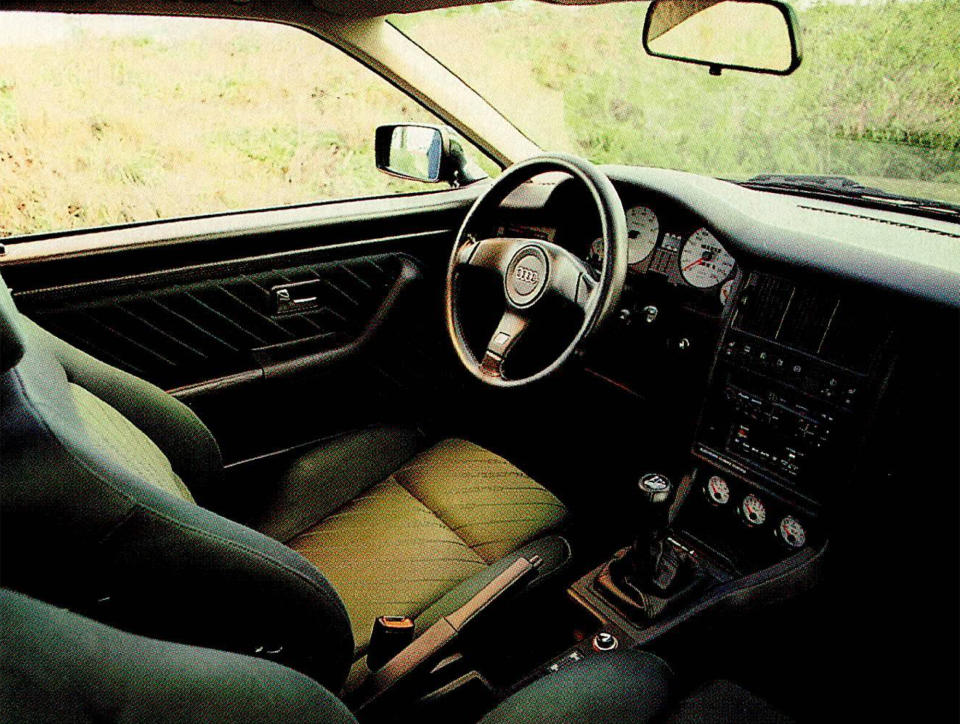
The two Evolution cars, on the other hand, were praised for the excellence of their steering feel and turn-in, with the BMW coming out as the favorite: "The M3's power steering is the best of the group. It is nicely weighted, has good feel and is quick around center."
Modifying the stock suspension setups of the Mercedes 190E. the Audi Coupe and the BMW M3 for the competition versions of each was anything but a complicated matter of redesigning components or re thinking layouts for the race track. The course of action chosen by all three manufacturers was. instead, a relatively simple one of adding more girth to the cars' already athletic suspension muscle, spring and sinew.
Throughout the two-year history of its sports-minded Evolution models, Mercedes-Benz has generally left the stock 190E 2.5-16 front suspension of modified MacPherson struts, lower A-arms, springs, shocks, anti-roll bars and hydropneumatic leveling in place. The primary suspension build-up on both last year's Evolution I and our Evolution II test car involves a strengthened version of the standard sedan's multilink rear suspension. And just to even things out, as it were, the Evo II's suspension system is also equipped with a hydropneumatic self-leveling control system.
Tested and finalized at the Nurburgring, the Audi Coupe S2's upgraded suspension features stiffer springs and shocks, and thicker anti roll bars. For added chassis rigidity, a cross-brace has been installed between the front shock towers.
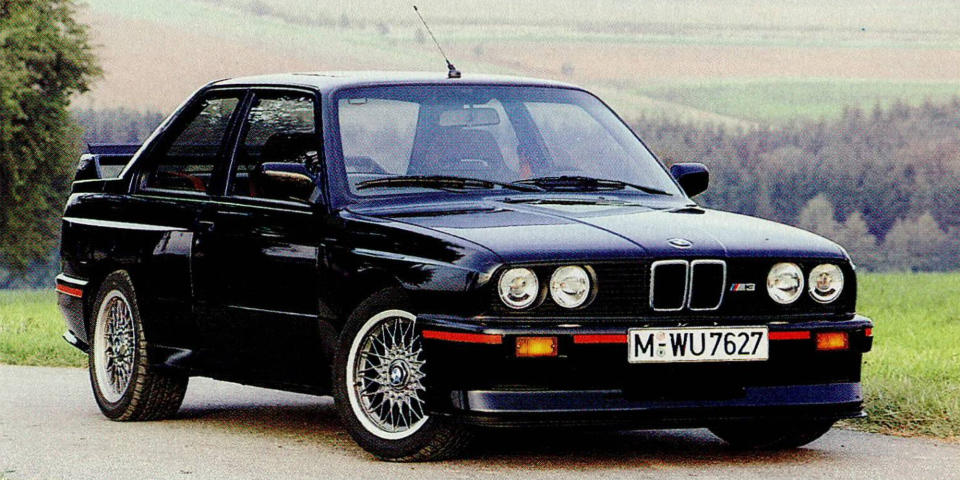
In creating an Evolution model of the M3, BMW has addressed one of our chief reservations about the M3 models currently zooming around in the U.S.: namely, handling-versus-ride. The "sport suspension tuning" version on the standard M3 (recalibrated springs, shocks, anti-roll bars and bushings at both ends with MacPherson struts and lower A-arms in front, semi-trailing arms at the rear) is great for spirited driving, but a tad too stiff for comfortable everyday use. In response to this problem, Munich has endowed the M3 Sport Evolution with EDC (Electronic Damping Control), BMW's version of cockpit-adjustable shocks. Just select your current mood from the rotary dial on the center console-Comfort, Normal or Sport-and you're off, ready for sport or pleasure, a point not missed by at least one driver: "The adjustable suspension on the BMW transforms it. I don't like the M3 we have in the U.S., but this car is really different, much better. And the adjustable suspension has a lot to do with it. The Normal setting is best, with just a little body roll and still a lot of handling."
Other editors were even more effusive in their praise of the BMW's sportiness." The tires grip like spikes, and the chassis is well-nigh impossible to upset. The M3's stability, handling and road feel remind me more of a race car than of a street car set up for extra-urban activities. The Mercedes, on the other hand, feels like a luxury sedan resisting the transformation from street car to track car."
Drivers who preferred the Mercedes appreciated its ride/handling balance and its tendency to be less temperamental than the BMW: "Drop-throttle tuck-in is just right for an average driver and sufficient for an expert. The BMW has more tuck, which makes it better for an expert driver."

Although there isn't any mention of Audi's full-time all-wheel-drive system in the proper name of the Coupe S2, the car is definitely a Quattro, with all of the best and worst traits that go along with that.
The first entry in the Quattro's credit column is the extra stability and peace of mind that come with having four wheels pulling for you instead of just two. The Quattro system features a Torsen center differential and a rear differential that can be locked manually from inside the car by pressing a button.
The S2's Quattro edge was instrumental in enabling it to keep up with the BMW and Mercedes on snakey, twisting roads, the awd making up for the rear-wheel-drive cars' advantage in rubber: The Audi gave pursuit on 205/55ZR-16 tires, while the BMW rode on 225/45ZR-16s, and the M-B was hoofing on 17-in. wheels shod with 245/40ZR-17 tires.
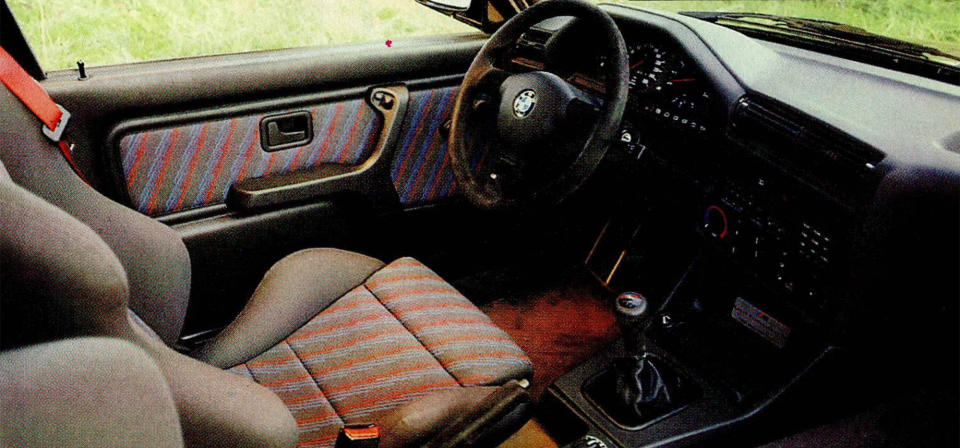
So what price does the Audi Coupe S2 have to pay for its four-footed stability? Well, all-wheel- drive cars, from the Subaru Justy to the Porsche 911 Carrera 4, understeer and the S2 is no exception. "Although the Coupe S2 is very forgiving and easy to drive at speed (it has a fair amount of body roll), it understeers-almost to the point of being frustrating at times," lamented one of the editors.
The added weight of the Quattro system aggravated the condition, and the Audi ended up behind the BMW and Mercedes (which exhibited better balance and more poise) in high-speed transitional maneuvers like our slalom testing.
As far as top-speed runs go, we managed to find a few rare miles of Autobahn that weren't overcrowded, so we were able to stretch the cars' legs a bit. Our three coursers were all so smooth and tracked so steadily at their preset limits-154 mph for the Audi, BMW and the Mercedes (manufacturers in Germany have agreed upon a limited top speed of about 155 mph for their sedans)- that it almost made the thrill of speed without legal limits seem common. The kick was in how each car got there: the Coupe S2's turbo whining and reaching out for more power: the Evolution II's engine building toward a peak as the revs in creased; and the M3 Sport Evolution's engine pulling relentlessly up through its wide powerband.
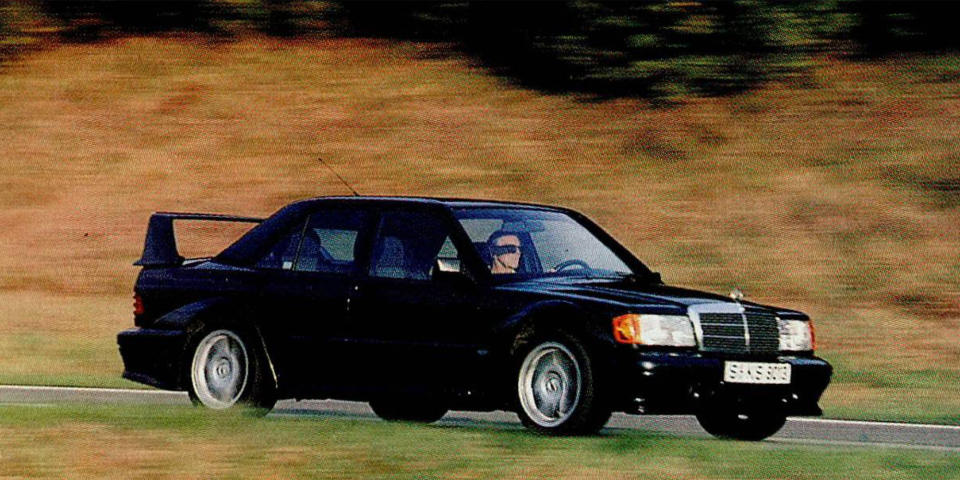
Braking is a crucial aspect for cars of this caliber, so it pleases us to report that the stopping characteristics of all three competitors were excellent. The Mercedes and BMW (both sporting beefier disc brakes than their non-race-ordained counterparts) were nearly parallel performers, while the Audi had to give up a few feet to its lighter rivals. ABS, fitted to all three cars, takes the variable of driver skill out of the equation for quick stops. Only the Audi, however, offers the added option of an ABS override button for drivers who like to take threshold braking into their own hands.
Our notebooks contained laudatory remarks for the braking of all three cars, but it was track driving that really allowed us to test the mettle of the cars' braking systems:
"The Audi's brakes got a bit spongy after a track session with some fairly hard braking."
"The Mercedes' brakes are excellent: I experienced no fade after 20 consecutive fast laps on Hockenheim's short circuit."

As any peacock will tell you, being voted top bird in the aviary isn't everything-how you show off your feathers counts for a lot. By the same token, the Mercedes-Benz 190E 2.5-16 Evolution II didn't garner any winning votes in the performance category. But it attracted more attention than the other two "birds" combined. Being a 4-door sedan had a little to do with it: The Evo II is slightly longer, wider and lower than either the 2-door BMW or the Audi Coupe. But what really pushes the Mercedes over the top as far as looks go is its sensational, trunk-mounted rear spoiler. No other aerodynamic piece on the car can even approach it. The snarling fender blisters, adjustable front air dam and aero rear bumper play functional second fiddle to the most outrageous wing since the Plymouth Superbird.
The BMW's adjustable rear wing looks half-hearted by comparison. Munich lowered the M3's nose by about a half-inch while creating the Sport Evolution, and it flared the fenders even more to accommodate the SE's wider-than-stock-M3 tires.
But the BMW is still no match for the Mercedes in the double-take department, although most of us agreed that the overall appearance of the BMW was more integrated and less tacked-on-looking than its Evolution counterpart from Stuttgart.
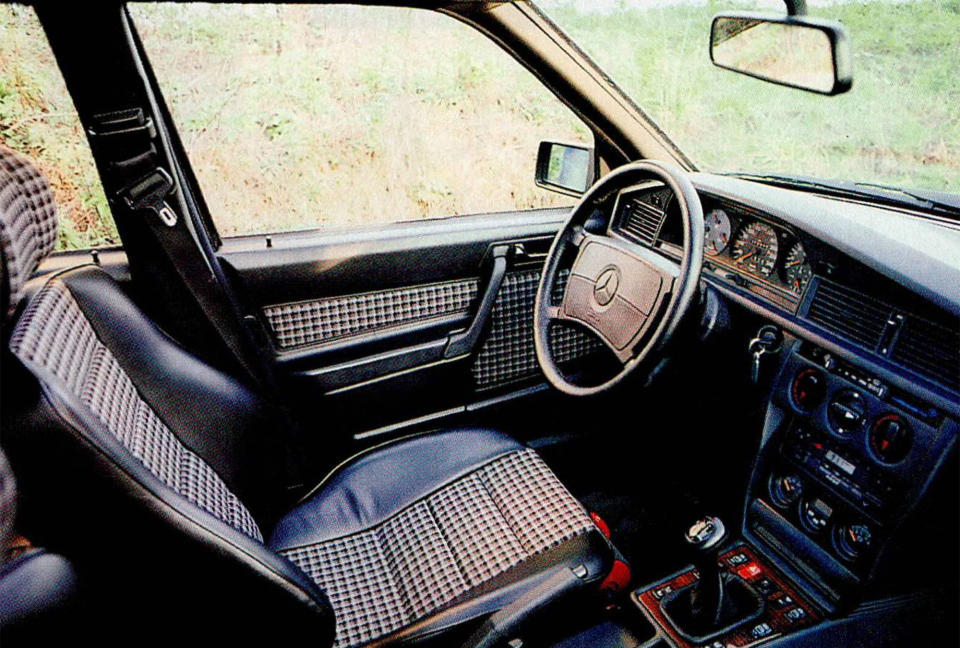
Then again, it's hard to argue with the M-B's 0.30 coefficient of drag (the BMW's is 0.35). A ride-height adjustment switch, located on the dash, allows the Mercedes to hunker even closer to the ground for a little extra aerodynamic advantage.
Evolution II's air management is an opaque plastic deflector fitted over the upper portion of the rear window. This piece was a constant source of complaints because it reduced the driver's rearward vision dramatically. We understand that we are not alone in our frustration with the deflector because at least one M-B project engineer has cut out a large section from it on his personal Evolution II.
The Audi Coupe S2 is distinguished from other Audi Coupes principally by its new front-end treatment (based on the V8 model), special 5-spoke alloy wheels and S2 badges placed front and rear.
One would be hard pressed to find a better mix of sporting-yet-comfortable interiors than in these three cars. The Audi was generally looked upon as the comfort leader and the BMW as the race driver's choice, but all three boasted snug, supportive seats, grippy steering wheels and big, readable gauges.

The Mercedes' interior is characterized by the feeling of businesslike austerity that German cars are known for. That isn't a complaint, just an observation. One editor, in fact, could have stood with a little less opulence in favor of lightening the car's load: "Comfort is quite acceptable for a car in which handling is a priority," he noted, "although I would prefer a car not so burdened with weighty gimmicks such as air conditioning and electric windows."
Such restraint was shown in the BMW, which, while it did have air conditioning, had manual-crank windows. There is an air of race readiness about the M3 Sport Evolution's cockpit. The tactile sensation of the steering wheel wrapped in brushed black leather is enough to get one itching to do hot laps. The distinctive BMW Motorsport blue and red, stitched into the upholstery of the M3's superb seats, adds to the effect.
In the Audi, the stitching says "Quattro," and the seats are just as nice. Our Coupe S2's seats were done up in a green fabric that was designed to complement the lush, deep green color of the car's exterior paint. The Audi's elevated comfort level was noted by all. Its light gray faced gauges made an impression on us as well, earning praise from some, while others thought they looked gimmicky.
Our final tally found the editors evenly divided between the BMW M3 Sport Evolution and the Audi Coupe S2 as the sports car of preference.
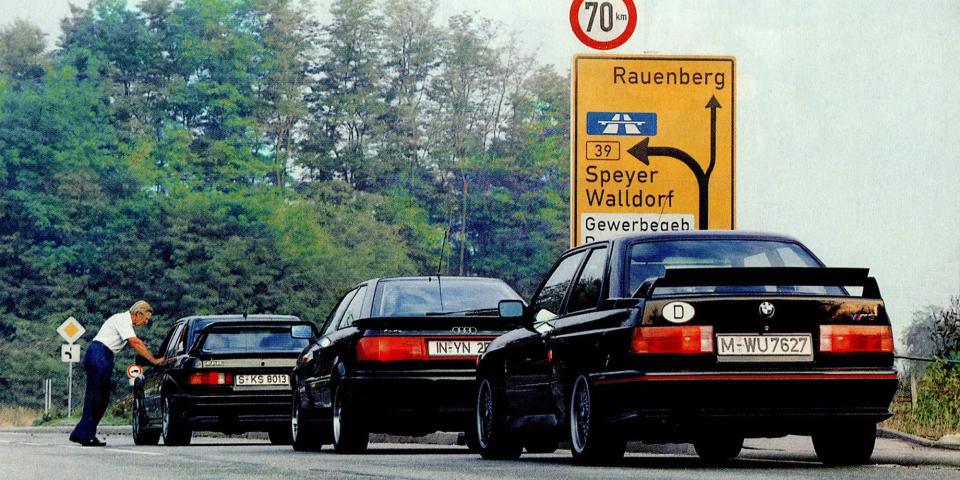
" I was astonished that the Audi was my choice as the winner among the three cars," confessed one driver. "I liked it best because of the all wheel drive, and I thought it was the best all-around car. It would be a great skier's car, for instance, and it's easy to drive every day as well. If I had to buy one car from the bunch, it would be the Audi."
"For me. the M3 Sport Evolution is the easiest to drive of the three cars in this test," responded a second editor. "Whether I was running it around Hockenheimring, tooling through the city, or opening it up on the Autobahn, the BMW felt right at home. With just enough gear selected, the power rolls on beautifully, and the engine pulls like a demon."
A third editor put the debate into perspective by saying, "The Audi is the most civilized of the trio, but the M3 is the greatest fun of the group."
And the Mercedes-Benz 190E 2.5-16 Evolution II-still a knockout performer-got stuck somewhere in the middle, playing bridesmaid to one car that was a better road automobile and to another that was a better Evolution.
The gap between the Mercedes and the other two cars is widened even further when price is taken into consideration. At $72,960. the Evolution II is easily the most expensive car in the group, followed by the M3 Sport Evolution at $56,700. The quick and comfy Coupe S2 stands out as the bargain of the field tagged at $45,700. True, the Audi is a bit less exclusive than the other two contenders-Mercedes is only building 500 Evo IIs (and all are spoken for), BMW is drawing the line at about 600 Sport Evolution M3s-but it also has the best chance of finding its way to North America.
Until then, we can take comfort in our memories of the race track in the woods, Baden-Wurttemberg's back roads, the fleeting wonder of the Autobahnen and the excellence displayed by our three favorite traveling companions.

 Yahoo Autos
Yahoo Autos 